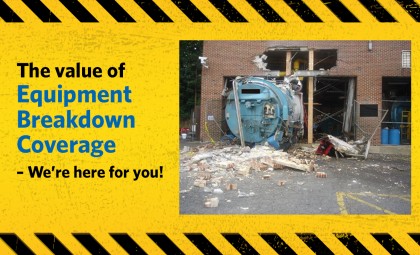Why do healthcare facilities need equipment breakdown coverage?

November marked the launch of our Property Loss Prevention Manual.
Have you downloaded your copy yet?
As your trusted insurance and healthcare safety advisor we’re always on the lookout to find opportunities to share knowledge with our valued Subscribers.
We do this through the many resources we create for you, additionally, we also recently hosted a property-themed episode of Talk with HIROC.
Our primary goal in all of this is to ensure you and your teams have the right information to make important decisions.
We hope you find this article courtesy of our partners from HSB Canada helpful.
As always, our team is here for you – if you have any questions, please feel free to reach out to us at [email protected]
Why do healthcare facilities need equipment breakdown coverage?
Healthcare operations depend on boilers, electrical systems, air conditioning and refrigeration units, phones, computers, and medical equipment. This equipment is subject to sudden and accidental breakdown. A breakdown can not only be expensive to repair, but can also cause interruptions and extra expenses.
Doesn’t a property policy cover equipment breakdown?
Traditional property policies exclude loss or damage caused by an equipment breakdown: electrical arcing, mechanical breakdown, and explosion of boilers and pressure vessels.
What does equipment breakdown insurance cover?
It covers the sudden and accidental, physical damage to equipment that requires its repair or replacement, and applies to several types of equipment.
Boiler and Pressure Vessel
Boilers and pressure vessels operate at high internal pressure. These vessels are commonly used for heat, hot water, steam production and processing. Accidents can occur due to defective welding, scale build-up or overpressure due to defective safety devices. Results of overpressure can be catastrophic.
Loss example: A hospital’s firetube boiler operated in a dry-fired state due to inoperative controls and safety devices. The sudden introduction of feed water caused the rapid expansion of pressure. As a result, the boiler furnace tube collapsed and the boiler exploded and travelled over 100 feet from its installed position, causing extensive property damage. One person was seriously injured.
Electrical equipment
Electrical equipment is used for generation, transmission or utilization of electrical power.
Electrical systems represent up to 15% of a building’s value. Components include transformers, panels and cables, and because these are interconnected, excessive voltage in one component can lead to significant damage to others. For example, arcing can cause damage to a panel, as well as completely shut down an operation.
Air Conditioning and Refrigeration
Air conditioning and refrigeration equipment represent the number one source of breakdown claims, as they contain a variety of equipment such as pressure vessel, mechanical, electrical and electronic. And, because many air conditioning units are located on the roof, a crane or helicopter may be required to remove or replace a unit.
Refrigeration loss example: A temperature control on a clinic’s refrigerator containing medication failed. Losses included spoilage of the refrigerator’s medication contents.
Computer and Communications
Computer and communications equipment includes network, telephone, security and fire alarm systems. These systems rely on very sensitive electronic technology. Common causes of failure include power surges, loose connections, vermin, foreign objects, excessive moisture and improper use.
Microelectronics are the brains that control equipment, from boilers to computers. This microscopic and fragile technology is more prone to damage, and that damage is invisible to the naked eye.
Electronic Circuitry Impairment is a new cause of loss for failures when physical damage is so small, it is not detectable. If replacing circuitry makes equipment work again, Electronic Circuitry Impairment is triggered, even if there is no physical evidence of damage.
Loss example: Computers in a medical centre were damaged by a power surge that came through the data network lines. Surge suppressers were on electrical and communication lines, but not on data network lines.
Mechanical
Mechanical equipment is used for generation, transmission or utilization of mechanical power. Mechanical equipment includes elevator and escalator motors, ventilation fans, water pumps, motors and combustion engines.
This equipment is mission-critical to most healthcare facilities. Common causes of mechanical failure include vibration, metal fatigue, seizing, misalignment or simple human error.
Today, more types of mechanical equipment are driven by sophisticated but fragile computer technology, making them even more prone to breakdown.
Loss example: An operator of a diesel generator inadvertently added glycol to the engine’s oil systems in the mistaken belief he was adding lubricating oil. As a result of the glycol contamination, the engines’ bearings, pistons and cylinder liners had suffered extensive overheating and damage. The owner incurred extra expenses by having to purchase additional power from the local utility while the engines were being repaired.
Renewable Energy and Alternative Energy
“Renewable and alternative energy” technology can take many forms, including solar, wind, geothermal and bio-fuels. It typically employs a wide range of electrical and mechanical equipment.
Equipment breakdown insurance covers exposures that are normally excluded in other property insurance policies. Insurance company inspections may also help reduce the likelihood of breakdowns to insured equipment. For more information about Equipment Breakdown insurance please email Jean Asuncion, HIROC’s Engineering Liaison Associate at [email protected].
Content source: HSB Canada